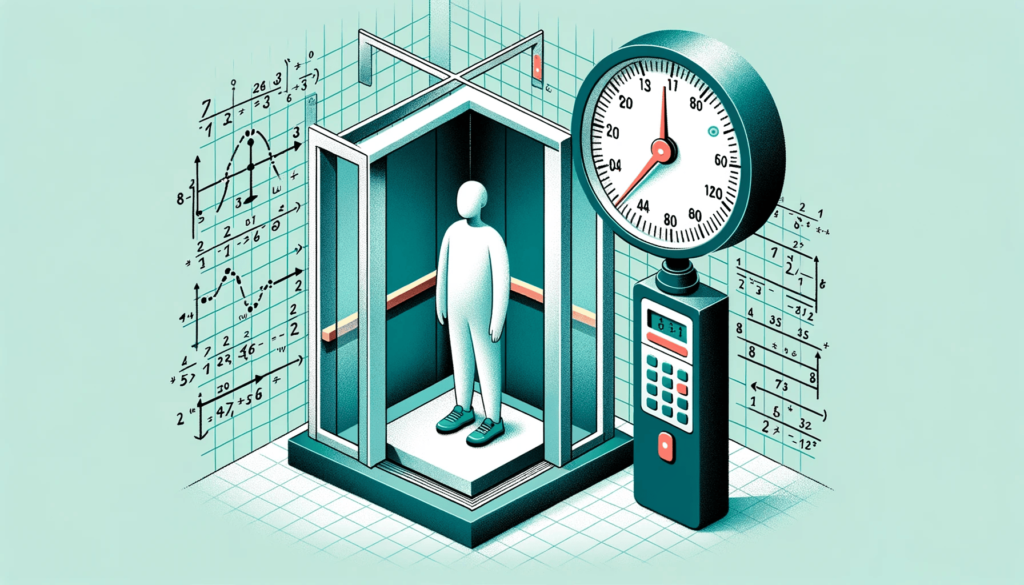This course article contains videos that can only be accessed once enrolled in the Learn AP Physics from Scratch Course.
Unit 2 Breakdown
You are on Lesson 5 of 8:
- Unit 2.1 | Understanding and Applying Newton’s Law in Depth
- Unit 2.2 | Common Linear Forces, Equations, and Misconceptions
- Unit 2.3 | Drawing and Understanding Force Body Diagrams
- Unit 2.4 | Deriving Equations to Solve Linear Force Problems
- Unit 2.5 | Advanced Force Problems – Tension and Elevators [Current Lesson]
- Unit 2.6 | Advanced Force Problems – Ramps (Inclines)
- Unit 2.7 | Advanced Force Problems – Pulley System
- Unit 2.8 | Advanced Force Problems – Multi-Body System
In this lesson:
- Solve tension and elevator problems
- Practice hard static tension problems (hanging signs)
- Practice non-static tension problems (moving elevators)
- Learn what apparent weight is
New Problems, Same Framework
Attempt to solve the questions below before watching the video solution (will show for enrolled course members)
Note that I will use the exact framework covered in the last lesson to solve all problems: (1) draw an FBD, (2) Find net forces in the x and y direction, (3) use F = ma, and (4) Solve!
Problem #1
Question – A large 30kg ladder is suspended from the top of a building by two ropes. The rope on the left makes an angle of 50° angle to the vertical, while the rope to the right makes a 70° angle to the horizontal. What is the tension in the left rope?
Problem #2
Question – A 1000 kg elevator traveling down, accelerates down at a rate of 2 m/s2. Find the tension (T1) in the elevator cable. Now suppose an identical elevator traveling up decelerates at a rate of 2 m/s2. Find the tension (T2) in the elevator cable.
PS #1 and #2
Apparent Weight
Apparent weight is what something seems to weigh.
Image yourself on a roller coaster. There are some points where you will feel very light and, some points where you feel very heavy.
Throughout the ride, however, you never actually lost or gained weight. It’s just what we feel.
This situation also happens in elevators, cars, in the pool, etc. Imagine going over a bump on the road. You will momentarily feel lighter.
This is what we call apparent weight, and it’s really just our normal force.
Visual Representation
Below are two FBDs of the same person, John, demonstrating apparent weight.

#1 shows a John standing on the ground. This is his “normal state.” John will feel neither light nor heavy.
#2 shows a John with his normal force greater than his weight. He will feel heavier than he actually is since the ground (normal force) is greater than usual.
#3 shows John with a normal force less than his weight. He will feel lighter in the situation since the ground is not pushing on him as hard as it normally does.
Finding Apparent Weight
You can solve for apparent weight, by calculating normal force.
Stepping on a scale reads your normal force (how hard it pushes back on you) rather than your weight (how hard you push on the scale)
For example, imagine sitting on scale while riding in your car. Now lets say you travel over a road bump. You will slightly lift of the scale, causing the scale to show a lower number than your actual weight.
Normal Force
In other words, your apparent weight is just the normal force — how hard the seat pushes against you, whether you are in a car, rollercoaster, or elevator.
The harder you push down, the harder the seat will push back (Newton’s 3rd Law) and the heavier you will feel.
The less you push down, the less the seat will push back. And the lighter you will feel.
So apparent weight isn’t real.
It’s just what you are feeling pushing back on you.
Practice Apparent Weight
Right now we will focus on apparent weight in elevators. In later units we will cover how to do this on rollercoasters and more complex situations.
Solve the apparent weight question below, then check you answer.
- You are standing in an elevator traveling upwards and decelerate at a rate of 3.1 m/s2. What is your apparent weight, given that on the ground you weight 755 Newtons.
- A man has a mass of 82kg. While standing in an elevator that is accelerating upwards at 1.3m/s2, what is the true and apparent weight of the man?
- A man has a mass of 102kg. While riding in an elevator, he has an apparent weight of 725N. Is the elevator accelerating upwards or downwards? What is the acceleration of the elevator?
Show Answers
- 516.4 N
- 800 N, 910 N
- Downwards, -2.7 m/s2
Practice Set 1 (Easy)
- 60 kg woman stands in an elevator that is accelerating downward at 3.10 m/s2. What is her apparent weight.
- A person with mass of 78 kg is riding in an elevator that is accelerating upward at 1.80 m/s? What is the person’s apparent weight?
- A girl whose weight is 500 N hangs from the middle of a bar supported by two vertical strands of rope. What is the tension in each strand?
- A 50-N lantern is suspended by a pair of ropes with 120 degrees between them (each 60 degrees from the vertical). What is the tension in each rope?
Show Answers
- 402.6 N
- 905.6 N
- 250 N
- 288.7 N
Practice Set 2 (Difficult)
- The maximum force that a grocery bag can withstand without ripping is 250 N. Suppose that bag is filled with 20.0 kg of groceries and lifted with an acceleration of 5.0 m/s2. Do the groceries stay in the bag? Why or why not?
- Three small children of mass 20.0 kg, 24.0 kg and 16.0 kg hold hands and are pulled across a frozen pond (assume no friction) by a larger adult who is on skates. The adult pulls on rope attached to the 20.0 kg child with a force of 135 N. Calculate the acceleration of the group.
- Three people argue over a 15 kg wagon, and a tug-of war breaks out. The largest person pulls on one side with a force of 35 N, while the other two pull from the other side each with a force of 30 N. If µ = 0.12 between wagon and ground, determine the resultant acceleration.
- A 10-kg block is hanging from the ceiling through two ropes, T1 and T2. The angle between the two ropes and the ceiling are 60° and 30° degree respectively . What is the tension in each rope?
Show Answers
- The groceries will NOT stay in the bag . The upwards force (300 N) is greater than the bags maximum force (250 N) it can withstand.
- 2.23 m/s2
- .49 m/s2
- T1 = 86.6 N, T2 = 50 N
Lesson 2.5 Recap
In this lesson we covered how to solve tension and elevator problems. You learned that solving these problems are no different than solving any other force problems.
If you follow the framework for solving force problem you’ll be able to solve even the hardest of questions. So be sure to practice is as we will continue to use it in many lessons to come.
We also discussed apparent weight. This was the phenomenon of momentarily feeling lighter or heavier in certain situations, despite not loosing actual weight.
Lesson 2.6 Preview
In the next lesson we cover another common type of force problem: objects on an incline. This one can be tricky. As you know, however, using our framework will help us solve the problem with ease.


